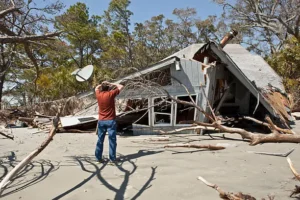Dallas weather doesn’t just make for dramatic skies and power-packed thunderstorms—it can shake up your finances, too. Every spring and early summer, as dark clouds roll in from the plains, homeowners across North Texas brace for hail, wind, and sometimes tornadoes. But while most people focus on boarding windows or parking cars under cover, there’s one thing many overlook until it’s too late—their insurance deductible in Dallas.
That number on your policy? It’s not just a random percentage or dollar figure. It’s the difference between getting back on your feet quickly and draining your savings after the next big storm.
Let’s break it all down—without the jargon, without the fine print fog—and talk about what really matters for Dallas homeowners, especially during peak weather season.
Key Takeaways:
- Dallas homeowners face percentage-based wind/hail deductibles (1%–5%).
- Timing and storm “triggers” affect when and how deductibles apply.
- Review, document, and mitigate before peak storm months (March–June).
- Understand whether your policy defines deductibles per event, per season, or per year.
- A smart, proactive review of your insurance deductible in Dallas can save you thousands—and a lot of stress.
The Dallas Weather Reality Check
Dallas doesn’t sit on a coastline, but it lives under one of the most active skies in the country. Hailstorms the size of golf balls? Check. Sudden 70-mph gusts? Absolutely. Tornado warnings flashing across your phone in April? Par for the course.
From March through June, North Texas enters what insurance companies call “peak convective season.” In plain English: it’s the stretch when wind and hail claims spike. That’s when your insurance deductible in Dallas starts to matter more than you realize.
Why? Because most policies here aren’t based on a small, flat deductible like $500 or $1,000. Instead, they’re based on a percentage of your home’s insured value. And that can add up fast.
What Exactly Is an Insurance Deductible?
Let’s keep this simple.
A deductible is what you pay out of pocket before your insurance company covers the rest. It’s your skin in the game. For example, if your roof suffers $20,000 in storm damage and your deductible is $3,000, you pay that $3,000 before your insurer steps in.
Sounds manageable—until you realize that in Dallas, most wind or hail deductibles aren’t a fixed dollar amount. They’re a percentage of your home’s insured value.
So if your home is insured for $400,000 and your deductible is 5%, you’re on the hook for $20,000 before a single dollar of your claim gets paid. That’s not pocket change.
The Types of Deductibles You’ll See in Dallas
Not all deductibles are created equal. Here’s a quick look at how they differ:
| Type of Deductible | What It Covers | How It’s Calculated |
| Standard (All Perils) | Fire, theft, minor incidents | Usually a flat dollar amount ($500–$2,500) |
| Wind/Hail Deductible | Damage from windstorms, hail, or tornadoes | Percentage of insured value (1–5%) |
| Named Storm Deductible | Damage from officially named storms | Percentage of insured value (1–10%) |
| Catastrophic (CAT) Deductible | Applies to major, declared disasters | Often high percentages; varies by policy |
In Dallas, it’s that middle row—wind/hail deductibles—that most homeowners deal with. And because hailstorms and wind damage are common here, insurers have adjusted their terms to balance risk. That means higher deductibles for high-risk areas.
Why Weather Season Timing Matters
Here’s where it gets interesting.
Insurance doesn’t just depend on what happens—it depends on when it happens. During high-activity months, insurers often tighten claim reviews and apply stricter “storm triggers.” A storm trigger is the event definition that determines when your deductible applies—like when the National Weather Service declares a severe storm in your ZIP code.
If you’re caught in back-to-back storms during April and May, your policy might treat those as two separate events. That could mean two separate deductibles.
It’s like paying double for the same roof if the timing overlaps the wrong way. And yes, that happens.
To make it even more complex, some policies define deductibles per event, while others use per season or per year rules.
That small detail can change your financial outcome dramatically.
So before storm season rolls in, read that section of your policy carefully—or have your insurance agent explain it line by line. Timing really is money in this case.
The Dallas Wind & Hail Connection
Dallas sits right in the bullseye of “Hail Alley.”
Each year, billions of dollars in insured losses come from roof and window damage caused by hail. And because these events are so frequent, insurers structure deductibles specifically around them.
That’s why you’ll often see a separate wind/hail deductible on your policy. It’s not there to be confusing—it’s there because these events are expected.
For most Dallas homeowners:
- Wind/hail deductibles range from 1% to 5%.
- Higher deductibles mean lower monthly premiums.
- Lower deductibles mean higher monthly costs—but less financial pain when filing a claim.
Choosing between the two is a balancing act. You’re essentially deciding whether you want to pay more now (through premiums) or later (through deductibles).
A Real-World Example
Let’s imagine you live in a North Dallas suburb, and your home is insured for $350,000.
A spring storm sweeps through, dropping baseball-sized hail that shreds your roof and gutters.
Your deductible is 2%.
- 2% of $350,000 = $7,000.
So you pay $7,000 out of pocket. Your insurance covers the rest.
Now let’s imagine you opted for a lower monthly premium but agreed to a 5% deductible instead.
- 5% of $350,000 = $17,500.
That’s a ten-thousand-dollar difference.
A big number to face when you’re also trying to replace your roof, fence, and maybe a few windows.
That’s why understanding your insurance deductible in Dallas before the next major storm hits isn’t just smart—it’s critical financial planning.
Hurricane, Named Storm, or Wind/Hail? Why It Matters Even in Dallas

You might think “hurricane deductibles” only apply to coastal Texas. True for the most part—but the definitions sometimes overlap.
Many insurers have switched to named storm deductibles, which apply to any weather system officially named by meteorologists. That includes tropical storms that bring high winds or flooding into North Texas.
Then there’s the wind/hail deductible, the most relevant to Dallas homeowners. It kicks in for any wind or hail damage, whether or not the storm has a name.
Here’s why the label matters:
If a policy uses the “named storm” clause, your deductible might apply differently—or more than once—depending on how weather services classify the event.
So don’t just assume your “storm coverage” covers everything. The trigger language defines how, when, and how much you’ll pay.
The Fine Print That Bites
Even the most comprehensive policies can hide costly details. These are the ones Dallas homeowners should check before storm season starts:
- Trigger Definitions: Look for when your wind/hail deductible activates—after any storm, or only after an official declaration?
- Multiple Deductibles: Does your policy reset after each event?
- Aggregate Caps: Some insurers cap how much you’ll pay in total deductibles each year. Others don’t.
- Multi-Building Rules: If you own multiple structures (like a detached garage or guesthouse), check if the deductible applies per structure or per location.
- Occurrence Periods: Some policies define a “storm event” as any damage within 72 hours of a declared weather event. That window can determine whether one or two deductibles apply.
These aren’t minor details—they’re the backbone of your storm-season financial risk.
Timing Your Claims the Smart Way
When it comes to filing claims, timing can save you thousands.
If your roof or property takes minor damage during storm season, it may be tempting to wait “just in case” another storm hits soon after. But delay too long, and your insurer could deny the claim for being “untimely.”
At the same time, filing multiple small claims in one year could push your premiums up or even lead to non-renewal.
Here’s the sweet spot:
- File promptly for significant damage.
- Document everything immediately (photos, videos, receipts).
- Consult with your agent before filing smaller claims to decide if they’re worth it under your deductible amount.
- Get a roof inspection right after any major hailstorm, even if you don’t see obvious damage—micro-fractures often worsen with time.
Your insurance policy is a financial tool, not a set-and-forget safety net. Use it strategically.
Preparation Tips Before Storm Season Hits
Want to stay ahead of peak weather season? Start with preparation that goes beyond the deductible math.
1. Review your policy every spring.
Rates and deductibles shift annually in Texas. Make sure your policy reflects your home’s current replacement cost—not what it was five years ago.
2. Confirm how your deductible applies.
Ask your insurer:
- Is it per event or per year?
- Does it apply to all wind/hail damage, or only “named” events?
- Is there an aggregate cap on how much you’ll pay out-of-pocket annually?
3. Check your roof’s age and rating.
Roof age affects both coverage and premiums. Impact-resistant roofing materials can qualify for discounts and reduce the likelihood of total replacement costs.
4. Document your home’s condition.
Take detailed photos of your roof, siding, and yard each year. They’re proof during a claim that damage came from a specific storm, not pre-existing wear.
5. Set aside an emergency fund.
If your deductible is percentage-based, your out-of-pocket cost may be substantial. Treat it like a savings goal—budget for it.
6. Consider mitigation upgrades.
Insurance companies often reward homeowners who install:
- Impact-resistant shingles
- Reinforced garage doors
- Storm shutters
- Roof tie-downs or clips
These improvements not only reduce damage risk—they can sometimes reduce your deductible or premium.
Mitigation: The Secret Weapon for Lower Costs
In the world of property insurance, mitigation simply means “reducing risk before it happens.”
In Dallas, that could mean:
- Trimming trees near the roofline to prevent impact damage.
- Replacing aging shingles with hail-rated materials.
- Installing gutter guards to prevent overflow during torrential rains.
- Sealing windows and doors to prevent wind-driven leaks.
These actions can lower your risk score with insurers and make you eligible for wind-resistant or hail-resistant discounts. Over time, those discounts add up—and can offset higher premiums or deductibles.
Replacement Costs vs. Actual Costs: The Hidden Deductible Factor
Here’s another often-missed layer. Your deductible interacts with your coverage type—whether your home is insured for replacement cost or actual cash value.
- Replacement Cost: Pays for what it takes to rebuild or replace your property with similar materials at current prices.
- Actual Cash Value: Factors in depreciation. That means older roofs, windows, or siding could result in smaller payouts.
If you’re on an actual-cash-value policy, your deductible may eat up most of your payout, leaving you with minimal coverage after a big storm. Switching to replacement cost coverage can prevent that.
How Weather Trends Are Changing Insurance in Dallas
Dallas weather is getting more intense, not less. Warmer temperatures fuel stronger convective storms, and the data backs it up—hailstorm frequency and size have risen across North Texas over the last decade.
As a result:
- Premiums are climbing.
- Deductibles are shifting higher.
- Coverage is tightening.
Insurers are reacting to increased claims, higher repair costs, and catastrophic losses statewide. For homeowners, this means one thing: staying informed and proactive is no longer optional.
Your insurance deductible in Dallas is no longer just a line item—it’s part of your long-term risk strategy.
How to Negotiate Smarter Coverage
Even if insurers set the base structure, you still have leverage.
Here’s how to optimize your policy before renewal season:
- Request multiple deductible options.
Compare premium differences between 1%, 2%, and 5% levels. Sometimes, lowering your deductible costs only a few extra dollars a month. - Ask for clarification on wind/hail definitions.
Ensure hail damage from any storm counts—not just “named events.” - Bundle smartly.
Combining home and auto policies often triggers better rates or deductible flexibility. - Review annually.
Property values change. So do deductible percentages. Make sure yours reflects your current home value and financial tolerance.
A Quick Reference Table
| Home Value | 1% Deductible | 2% Deductible | 5% Deductible |
| $250,000 | $2,500 | $5,000 | $12,500 |
| $350,000 | $3,500 | $7,000 | $17,500 |
| $450,000 | $4,500 | $9,000 | $22,500 |
| $600,000 | $6,000 | $12,000 | $30,000 |
Use this table to visualize what you’d owe in a major storm claim. If those numbers make you uncomfortable, it’s time to reassess your deductible before storm season begins.
Common Mistakes Dallas Homeowners Make
- Not reviewing their policy until after a storm hits.
By then, it’s too late to change anything. - Assuming the deductible is flat.
Percentage-based deductibles can surprise even experienced homeowners. - Filing too many small claims.
Each claim can affect your renewal rate, even if it’s under $2,000. - Ignoring roof inspections.
Hidden hail damage gets worse—and costlier—over time. - Misunderstanding “named storm” vs “wind/hail” coverage.
One wrong assumption can double your deductible after a claim.
Claim Preparation: When the Storm Passes
After a Dallas hailstorm, chaos usually follows—roofers knocking, insurance calls, adjusters everywhere. To stay in control, follow this quick recovery checklist:
- Document immediately.
Take photos and videos before any cleanup. - Secure the property.
Tarp your roof or cover broken windows to prevent further damage. - Call your insurer’s claims department.
Log your claim promptly, especially during high-volume seasons. - Meet your adjuster prepared.
Bring your photos, repair estimates, and receipts. - Track expenses.
Keep receipts for temporary housing or emergency repairs—they may qualify for reimbursement. - Ask for written clarification on how your deductible was applied to the payout.
The Emotional Side of Deductibles
It’s not just about numbers—it’s about peace of mind. A storm doesn’t just damage shingles and fences; it tests your sense of security. When you understand your deductible in advance, you make faster, calmer decisions. You avoid panic. You know what’s coming.
That confidence is worth more than the policy itself.
Final Thoughts: Control the Storm Before It Hits
Here’s the truth—Dallas weather will always be unpredictable. But your financial response to it doesn’t have to be.
By understanding your insurance deductible in Dallas, reviewing it before storm season, and aligning it with your comfort level and savings, you can turn uncertainty into control. You’ll be ready—not just to weather the storm, but to recover from it smarter, faster, and stronger.
The best time to prepare isn’t when the sirens wail or the sky turns green—it’s right now, while the skies are still clear.
FAQs
It’s the amount you pay out of pocket before your insurance company covers the rest of a claim—often a percentage of your home’s insured value for wind or hail damage.
Because North Texas frequently experiences severe hailstorms and high winds, insurers use these deductibles to manage the region’s high claim risk.
It’s calculated as a percentage of your home’s insured value—so a 2% deductible on a $400,000 home means you’ll pay $8,000 before coverage starts.
It applies when damage results directly from wind or hail events, regardless of whether the storm is officially named.
Yes, if your policy defines deductibles “per event” and multiple storms hit, you could owe the deductible each time.
Named storm deductibles apply only to officially named weather events, while wind/hail deductibles apply to any wind or hail damage.
You can often choose a lower deductible by paying a slightly higher premium or upgrading your home with storm-resistant features.
Review it each spring—before peak storm season—to ensure it still matches your home’s value and your financial comfort.
It can! Many insurers offer lower deductibles or discounts if you install impact-resistant roofing, reinforced doors, or storm shutters.
Document damage immediately, protect your home from further loss, and file your claim promptly to avoid delays or disputes.






